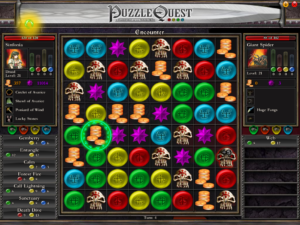Puzzle Quest: Gameplay Basics
 The heart of Puzzle Quest, the mode that you spend about 90% of your time in, is a competitive tile-matching game. There have been other competitive tile-matching games, such as Puzzle Fighter, but all others that I know of involve two players competing in realtime on separate playfields that affect each other indirectly at best. Here, we instead have the two players — or rather, the player and a computer opponent — taking turns in the same playfield. This alone has a profound effect on how the game is played. Normally, the player of a tile-matching game can expect to devote turns to setting up combos. But here, you actually want to avoid setting things up, lest your opponent take advantage of them before you can. There are ways to get multiple turns in a row — the simplest being to make four-in-a-row instead of three-in-a-row — but you can’t use such things most of the time.
The heart of Puzzle Quest, the mode that you spend about 90% of your time in, is a competitive tile-matching game. There have been other competitive tile-matching games, such as Puzzle Fighter, but all others that I know of involve two players competing in realtime on separate playfields that affect each other indirectly at best. Here, we instead have the two players — or rather, the player and a computer opponent — taking turns in the same playfield. This alone has a profound effect on how the game is played. Normally, the player of a tile-matching game can expect to devote turns to setting up combos. But here, you actually want to avoid setting things up, lest your opponent take advantage of them before you can. There are ways to get multiple turns in a row — the simplest being to make four-in-a-row instead of three-in-a-row — but you can’t use such things most of the time.
At root, the tile-matching works like Bejewelled: you swap two adjacent tiles in order to make at least one row of three or more, the matching tiles are deleted, and tiles fall downward to fill the empty spaces (possibly forming new matches and triggering a cascade of additional deletions). But instead of just increasing your score, the specific types of tile have different effects. Skull tiles do damage to the opponent when matched, and are the chief way you win combat, at least in the beginning. There are coin tiles which provide bonus cash and star tiles which provide bonus XP. The remaining four basic tile types provide you with four different colors of mana, corresponding to the four elements. With mana, you can cast spells.
I find the spellcasting aspect very reminiscent of Magic: The Gathering. Like M:tG, there are a variety of effects, from direct damage to status effects to things that manipulate the board, changing tiles or deleting an entire row at a time or whatever. Like M:tG, mana color is important, and, while you can accomplish things more efficiently by specializing in a particular color, over-specializing makes you vulnerable. And, like M:tG, you can spend large portions of a match waiting for the colors you need to come up. In fact, fishing for mana is even more frustrating here than in M:tG, because of the way that the mana source is shared: you can spend turns waiting for more red tiles to come up so you can cast the direct damage spell that will win the match, only to have them come up at the end of your turn and be immediately grabbed by the opponent.
I mentioned that specializing in a color makes things more efficient. This is mainy due to the Mastery skills. There are seven skills you can assign points to when your character levels, each increasing the benefits of one of the seven basic tile types. Raising your Fire Mastery skill, for example, will increase your red mana capacity, give you extra red mana for matching red tiles, and increase your chance of getting an extra turn when you match red tiles, thus making it possible to get red mana faster. So the more advanced your character is, the faster you tend to get mana in your areas of specialty. Eventually, this can make it more efficient to deal damage using spells than doing it directly with the skull tiles (unless you’re specializing in Battle, the skill that makes the skull tiles do more damage). I always find it satisfying when the rules of a game make the emergent strategies change over the course of play.
The nice thing about this whole system is that it isn’t just tile-matching embedded in an RPG frame. The tile-matching affects the RPG and the RPG affects the tile-matching in a very tight loop. They are inseperable; each alters how you think about the other. The story, on the other hand, is just tacked on, and is pointedly ignored by the game mechanics in ways that I’ll describe in my next post.
 Comments(1)
Comments(1)
[…] Puzzle Quest. Image by The Stack (http://www.wurb.com/stack/archives/357) […]